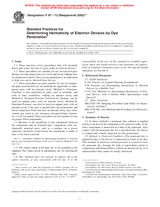Wir benötigen Ihre Einwilligung zur Verwendung der einzelnen Daten, damit Sie unter anderem Informationen zu Ihren Interessen einsehen können. Klicken Sie auf "OK", um Ihre Zustimmung zu erteilen.
ASTM F97-72(2002)e1
Standard Practices for Determining Hermeticity of Electron Devices by Dye Penetration (Withdrawn 2008) (Includes all amendments And changes 12/31/2010).
Automatische name übersetzung:
Standard-Practices für die Bestimmung Hermitezität Electron Devices durch Farbeindringprüfung (Withdrawn 2008)
NORM herausgegeben am 10.12.2002
Informationen über die Norm:
Bezeichnung normen: ASTM F97-72(2002)e1
Anmerkung: UNGÜLTIG
Ausgabedatum normen: 10.12.2002
SKU: NS-57123
Zahl der Seiten: 3
Gewicht ca.: 9 g (0.02 Pfund)
Land: Amerikanische technische Norm
Kategorie: Technische Normen ASTM
Die Annotation des Normtextes ASTM F97-72(2002)e1 :
Keywords:
dye penetrant, electron devices, hermetic seals, visual inspection, ICS Number Code 31.020 (Electronic components in general)
Ergänzende Informationen
| Significance and Use |
|
Contaminants that will reduce the effective life of electron devices may enter the device through small leaks. These leaks are most frequently found at seals between parts of the same or dissimilar materials. Leaks may also result from porosity of a defective portion of the case. Dye-penetrant procedures are applicable only to individual gross leaks in a system. The presence of a number of small leaks that may result in a cumulatively unacceptable leak rate when measured by other techniques will not be indicated if each individual leak is below the level of sensitivity of the test. There is no general agreement concerning level of leakage which is likely to be deleterious to a particular device. However, since these tests are designed to detect gross leakage, components that exhibit any indication of leakage are normally rejected. Since leaks may change in size with different ambient conditions, comparisons between test stations are not conclusive. Therefore these methods are usually employed as go, no-go tests. |
| 1. Scope |
|
1.1 These practices cover procedures that will normally detect and locate the sites of gross leaks in electron devices. 1.2 These procedures are suitable for use on selected parts during receiving inspection or to verify and locate leakage sites for production control. They are not quantitative; no indication of leak size can be inferred from the test. 1.3 These procedures are most suitable for use on transparent glass-encased devices; all methods are applicable to transparent parts with an internal cavity. Method A, Penetrant-Capillary, is also applicable to parts, such as terminals, end seals or base assemblies, without an internal cavity, and Method C, Penetrant-Pressure Followed by Vacuum, can be used on opaque parts with an internal cavity. Method B, Penetrant-Pressure, can also be used on opaque parts with an internal cavity if the part is opened after dye penetration and before inspection. Parts that have an internal cavity may either contain gas (such as air, nitrogen, nitrogen-helium mixture, etc.) or be evacuated. These procedures are not suitable for use on grease-filled components. 1.4 Because of the possibility of dye entrapment between the component and an attached part, components with mechanically attached parts, such as a radiator on a power transistor, should be tested before the attachment is made or after it has been removed. Note 1—Alternative methods for determining hermeticity of electron devices may be found in Practices F 98 (see 2.1) and Test Methods F 134 (see 2.1). 1.5 The values stated in SI units are to be regarded as the standard. The values given in parentheses are for information only. 1.6 This standard does not purport to address all of the safety concerns, if any, associated with its use. It is the responsibility of the user of this standard to establish appropriate safety and health practices and determine the applicability of regulatory limitations prior to use. For specific hazard statement, see Section 8. |
Empfehlungen:
Aktualisierung der technischen Normen
Wollen Sie sich sicher sein, dass Sie nur die gültigen technischen Normen verwenden?
Wir bieten Ihnen eine Lösung, die Ihnen eine Monatsübersicht über die Aktualität der von Ihnen angewandten Normen sicher stellt.
Brauchen Sie mehr Informationen? Sehen Sie sich diese Seite an.




 Cookies
Cookies
